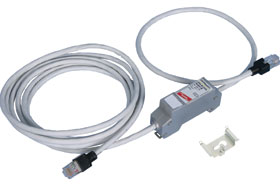

Ethernet is a family of computer networking technologies for local area (LAN) and larger networks that was commercially introduced in 1980 and has since been refined to support higher bit rates and longer link distances. It is assumed that all information such as data, voice, television, automation and control of machines and installations will be transmitted via Ethernet over the next years and Ethernet will therefore become a universal transmission concept.
When designing and installing an Ethernet network infrastructure, it is important to know what causes electromagnetic interference (EMI) so that you can achieve electromagnetic compatibility (EMC) in your network, ensuring its continuous and trouble-free operation. It is imperative to consider EMC at an early design stage, as this affects not only the data cables of the network, but also the entire electrotechnical infrastructure of buildings and building complexes where the entire network is installed. Consequently, it is important to consider the following electromagnetic environmental conditions:
• Are there potential sources of electromagnetic interference; such as radio-relay systems, mobile phone base stations, assembly lines or elevators?
• What about the quality of the electrical energy; for example, harmonics, flickers, voltage drops, excess voltages, transients?
• What about the risk of a lightning strike?
• Is there possible emission?
Bearing these factors in mind, the planning of a data network should include an earthing and equipotential bonding concept, which provides information on cable duct and cable routing, cable structure, active components, lightning protection, shielding of signal lines, equipotential bonding, and surge protection.
The most important measures to ensure EMC, and thus undisturbed data transmission, are:
• Spatial separation of known sources of electromagnetic interference of information technology components, such as transformer stations, elevator drives).
• Use of closed and earthed metal ducts in case of interference caused by strong radio transmitters and, if required, connection of the terminal devices via optical fibre cables only.
• Use of separate circuits for terminal devices and use of noise filters and uninterrupted power supply systems, if required.
• No parallel installation of power and data lines of terminal devices with power lines of powerful loads (due to the risk of high switching overvoltages when switching the loads on and off) and known sources of interference, such as thyristor controllers.
• Use of shielded data cables which must be earthed on both ends. Patch and connecting cables must be integrated in the shielding concept.
• Integration of the reinforcement (intermeshing) in the equipotential bonding system for metal enclosures and shields; for example cable trays and cable ducts.
• Shielded data cables and power lines should use the same riser duct in the secondary area. Separate riser ducts opposed to one another must be avoided. A distance of 20 centimetres between these two different types of cables should not be exceeded.
• The power lines for the devices and the relevant data lines must be basically routed via the same cable route. Separating webs should be provided. In the tertiary area, it is advisable to keep a maximum distance of 10 centimetres between these lines.
• If a lightning protection system is installed on the building, the safety distances between the power/data lines and elements of the external lightning protection system (such as air-termination systems, down conductors) must be kept and power/data lines must not be routed in parallel with the down conductors of the external lightning protection system.
• Use of optical fibre cables for the information technology cables of different buildings (primary cabling).
• Installation of surge protective devices in power circuits and for the tertiary cabling system to protect them from transients caused by switching operations and lightning discharges.
• Power installation in the form of a TN-S system to prevent interference currents on the shields of the data lines.
• Establishing main equipotential bonding with the power installation (PEN) at one point in the building, such as the service entrance room.
To ensure proper EMC protection, it is also important to choose adequate lightning current and surge arresters for information technology systems and to be familiar with their protective effect.
Conclusion
Modern communication networks are increasingly becoming high-frequency networks and thus more and more susceptible to interference. Therefore, a consistent EMC concept, that also includes lightning and surge protection for the buildings and systems, is required to ensure smooth network operation.
To ensure effective surge protection, the electricians and IT experts must coordinate the measures for the different systems in cooperation with the manufacturer of the device. In short, experts must be called in for larger projects.
For more information contact Alexis Barwise, Dehn Protection South Africa, +27 (0)11 704 1487, [email protected], www.dehn-africa.com

© Technews Publishing (Pty) Ltd | All Rights Reserved